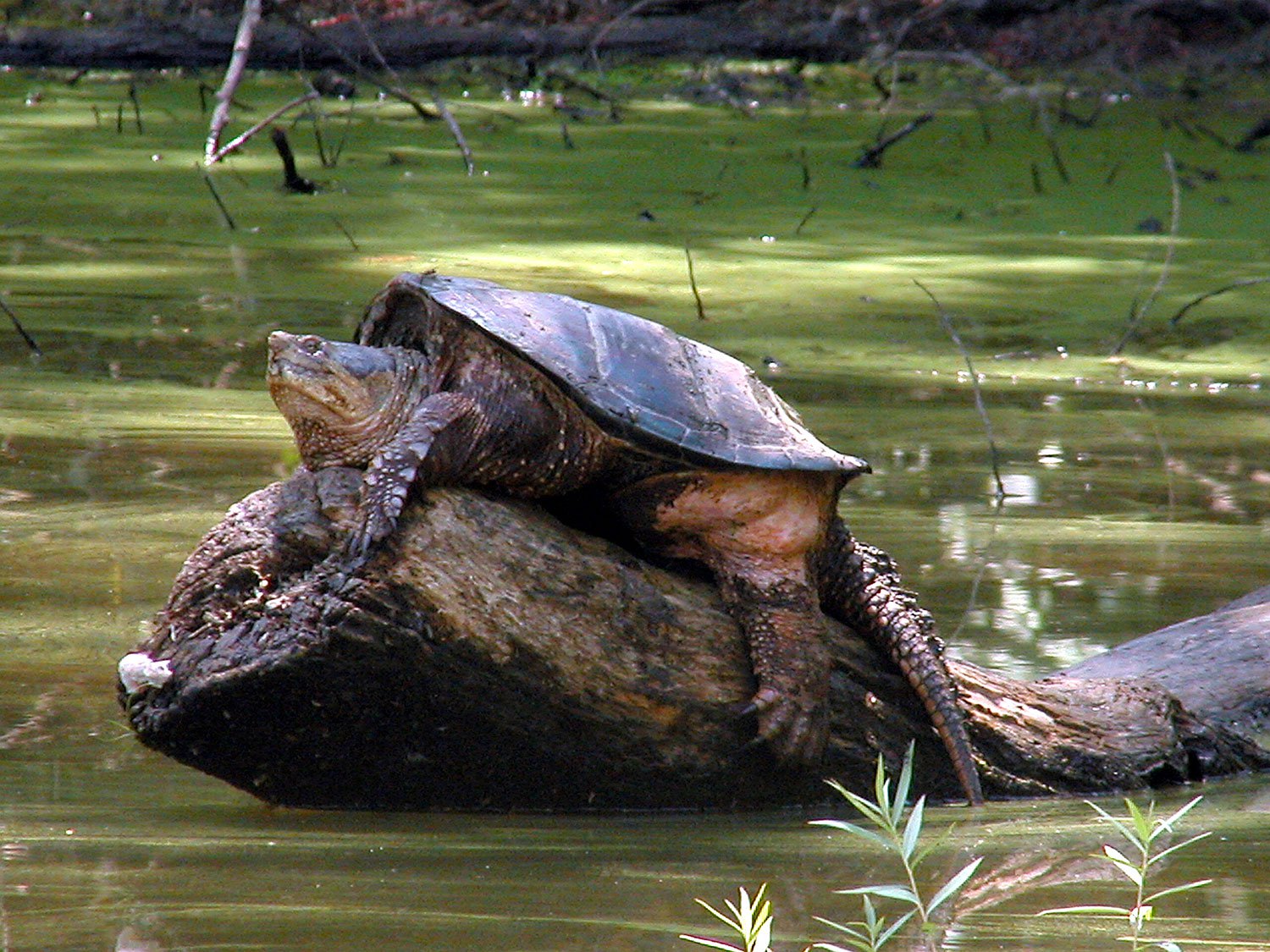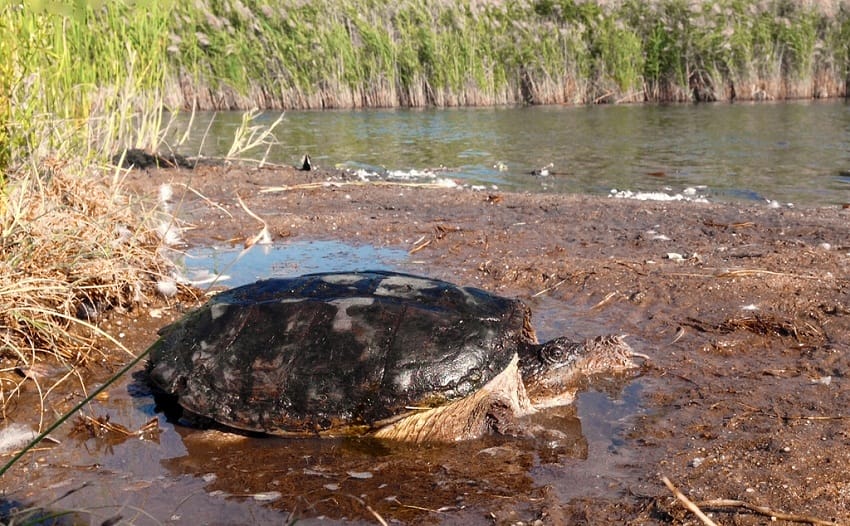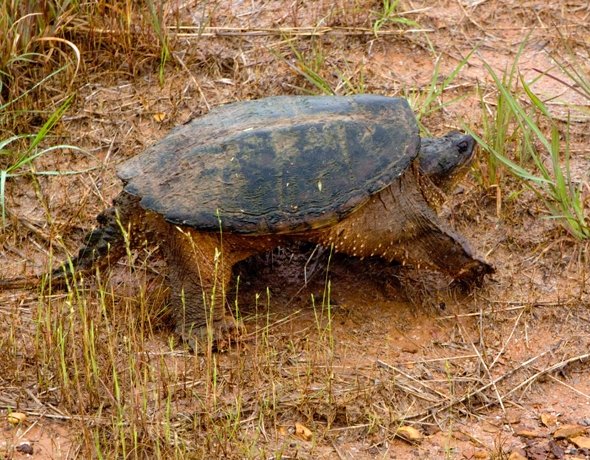
The common snapping turtle (Chelydra serpentina) is a species of large freshwater turtle in the family Chelydridae. Its natural range extends from southeastern Canada, southwest to the edge of the Rocky Mountains, as far east as Nova Scotia and Florida. The three species of Chelydra and the larger alligator snapping turtles (genus Macrochelys) are the only extant chelydrids, a family now restricted to the Americas. The common snapping turtle, as its name implies, is the most widespread.[2]
The common snapping turtle is noted for its combative disposition when out of the water with its powerful beak-like jaws, and highly mobile head and neck (hence the specific epithet serpentina, meaning "snake-like"). In water, it is likely to flee and hide underwater in sediment. The common snapping turtle has a life-history strategy characterized by high and variable mortality of embryos and hatchlings, delayed sexual maturity, extended adult longevity, and iteroparity (repeated reproductive events) with low reproductive success per reproductive event.[3]
Females, and presumably also males, in more northern populations mature later (at 15–20 years) and at a larger size than in more southern populations (about 12 years). Lifespan in the wild is poorly known, but long-term mark-recapture data from Algonquin Park in Ontario, Canada, suggest a maximum age over 100 years.[3]
Anatomy and morphology

C. serpentina has a rugged, muscular build with a ridged carapace (upper shell), although ridges tend to be more pronounced in younger individuals. The carapace length in adulthood may be nearly 50 cm (20 in), though 25–47 cm (9.8–18.5 in) is more common.[4] C. serpentina usually weighs 4.5–16 kg (9.9–35.3 lb). Per one study, breeding common snapping turtles were found to average 28.5 cm (11.2 in) in carapace length, 22.5 cm (8.9 in) in plastron length and weigh about 6 kg (13 lb).[5]
Males are larger than females, with almost all weighing in excess of 10 kg (22 lb) being male and quite old, as the species continues to grow throughout life.[6] Any specimen above the aforementioned weights is exceptional, but the heaviest wild specimen caught reportedly weighed 34 kg (75 lb). Snapping turtles kept in captivity can be quite overweight due to overfeeding and have weighed as much as 39 kg (86 lb). In the northern part of its range, the common snapping turtle is often the heaviest native freshwater turtle.[7]
Ecology and life history

Common habitats are shallow ponds or streams. Some may inhabit brackish environments, such as estuaries. Common snapping turtles sometimes bask—though rarely observed—by floating on the surface with only their carapaces exposed, though in the northern parts of their range, they also readily bask on fallen logs in early spring. In shallow waters, common snapping turtles may lie beneath a muddy bottom with only their heads exposed, stretching their long necks to the surface for an occasional breath. Their nostrils are positioned on the very tip of the snout, effectively functioning as snorkels.[8]

Snapping turtles consume both plant and animal matter, and are important aquatic scavengers, but they are also active hunters that prey on anything they can swallow, including many invertebrates, fish, frogs, reptiles (including snakes and smaller turtles), unwary birds, and small mammals. In some areas adult snapping turtles can be incidentally detrimental to breeding waterfowl, as they will occasionally take ducklings and goslings, but their effect on such prey is frequently exaggerated.[8] As omnivorous scavengers though, they will also feed on carrion and a surprisingly large amount of aquatic vegetation.[9]
Common snapping turtles have few predators when older, but eggs are subject to predation by crows, American mink, skunks, foxes, and raccoons. As hatchlings and juveniles, most of the same predators will attack them as well as herons (mostly great blue herons), bitterns, hawks, owls, fishers, American bullfrogs, large fish, and snakes.[7] There are records during winter in Canada of hibernating adult common snapping turtles being ambushed and preyed on by northern river otters.[6] Other natural predators which have reportedly preyed on adults include coyotes, American black bears, American alligators and their larger cousins, alligator snapping turtles.[10] Large, old male snapping turtles have very few natural threats due to their formidable size and defenses, and tend to have a very low annual mortality rate.[6]
These turtles travel extensively over land to reach new habitats or to lay eggs. Pollution, habitat destruction, food scarcity, overcrowding, and other factors drive snappers to move; it is quite common to find them traveling far from the nearest water source. Experimental data supports the idea that snapping turtles can sense the Earth's magnetic field, which could also be used for such movements (together with a variety of other possible orientation cues).[11][12]
This species mates from April through November, with their peak laying season in June and July. The female can hold sperm for several seasons, using it as necessary. Females travel over land to find sandy soil in which to lay their eggs, often some distance from the water. After digging a hole, the female typically deposits 25 to 80 eggs each year, guiding them into the nest with her hind feet and covering them with sand for incubation and protection.[13]
Incubation time is temperature-dependent, ranging from 9 to 18 weeks. In cooler climates, hatchlings overwinter in the nest. The common snapping turtle is remarkably cold-tolerant; radiotelemetry studies have shown some individuals do not hibernate, but remain active under the ice during the winter.[13]
In the northern part of their range snapping turtles do not breathe for more than six months because ice covers their hibernating site. These turtles can get oxygen by pushing their head out of the mud and allowing gas exchange to take place through the membranes of their mouth and throat. This is known as extrapulmonary respiration.[14]
If they cannot get enough oxygen through this method they start to utilize anaerobic pathways, burning sugars and fats without the use of oxygen. The metabolic by-products from this process are acidic and create very undesirable side effects by spring, which are known as oxygen debt.[14] Although designated as "least concern" on the IUCN redlist, the species has been designated in the Canadian part of its range as "Special Concern" due to its life history being sensitive to disruption by anthropogenic activity.[15]
Systematics and taxonomy

Currently, no subspecies of the common snapping turtle are recognized.[16] The former Florida subspecies osceola is currently considered a synonym of serpentina, while the other former subspecies Chelydra rossignonii[17] and Chelydra acutirostris are both recognized as full species.[16][18]










No comments:
Post a Comment
Note: Only a member of this blog may post a comment.